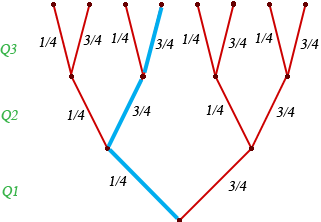| |||
| Math Central | Quandaries & Queries |
|
Question from jon, a student: a student is taking a multiple choice exam in which each question has four choices. (a) get five questions correct thanks for your help |
Hi Jon,
I would use a tree diagram to approach this problem. I drew a tree diagram but for an exam with only three questions.

For each question the probability that she gets the correct answer is 1/4 and the probability she gets an incorrect answer is 3/4. I have highlighted one possible result in blue. It is the result that she got the first question correct and the second and third questions incorrect. The probability of this result is 1/4 × 3/4 × 3/4 = 1/4 × (3/4)2. If you examine the tree diagram you will see that there are 3 results with exactly one question correct and hence the probability that she gets exactly one question correct is 3 × 1/4 × (3/4)2.
This analysis leads you to the binomial distribution. That is
The probability that she gets exactly n question out of 3 correct is
3! / ( n! (3-n)! ) × (1/4)n × (3/4)3-n.
Now try this for an exam with 5 questions.
Harley and Stephen
 |
||
Math Central is supported by the University of Regina and The Pacific Institute for the Mathematical Sciences.